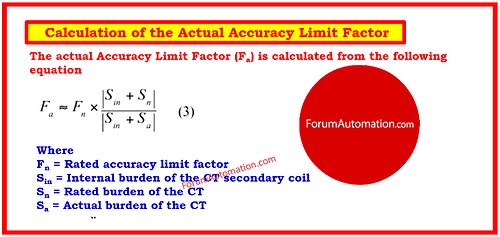To ensure the safety of the equipment connected to it in the case of a fault, the metering class CT must have a sufficient Instrument Safety Factor (ISF).
When there is a fault, the metering class CT saturates, protecting the attached measuring devices.
However, the accuracy limit factor for the protection class CT is essential in the case of an electrical network failure.
Compared to the metering class CT, the protection class of CT saturates at larger secondary current.
Protection during fault current is the main purpose of the protection class CT.
The protection class CT should not saturate with at-fault current; otherwise, the electrical network will not be protected.
In order to provide intact protection, the protection class CT must also continue maintaining its rated accuracy at the fault current.
What is Accuracy Limit Factor(ALF) of CT?
The ratio of the rated accuracy limit primary current to the rated primary current is known as the CT’s Accuracy Limit Factor (ALF).
CT is classified as either
- 5P10 (or)
- 5P20
for protection.
In this case,
- P represents protection class,
- 20 represents accuracy limit primary current, and
- 5 represents the CT’s composite error when accuracy limit current passes through the current transformer’s primary.
Example:
CTR is 200/1 and CT is 5P20.
The accuracy class is 5, and the ALF is 20.
This indicates that the CT reads the current with 5% accuracy if the primary is experiencing a fault with 20 times the rated primary current (4000 amperes). The accuracy limit factor (ALF) is this value: (In x 20)20.
The rated accuracy limit factor (ALF) and the actual ALF of CT may not match.
The following determines the accuracy limit factor (ALF):
- CT secondary coil internal burden,
- CT actual burden.
You can also follow us on AutomationForum.co, Facebook and Linkedin to receive daily Instrumentation updates.
You can also follow us on ForumElectrical.com , Facebook and Linkedin to receive daily Electrical updates.
